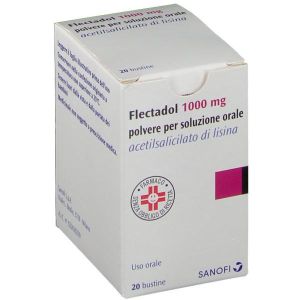NAME
FLECTADOL
PHARMACOTHERAPEUTIC CATEGORY
Analgesics and antipyretics.
ACTIVE PRINCIPLES
500 mg: 0.9 g lysine acetylsalicylate (equal to 0.5 g of acetylsalicylic acid); 1000 mg: lysine acetylsalicylate 1.8 g (equal to 1 acetylsalicylic diacid).
EXCIPIENTS
Glycol, mandarin aroma, glycyrrhizinated ammonium.
INDICATIONS
Pain of any nature and entity. Acute joint rheumatism and its complications. Primary and secondary degenerative arthropathies. Myalgia.
CONTRAINDICATIONS / SECONDARY EFFECT
In children and young people under the age of sixteen, in hypersensitivity to acetylsalicylic acid and salicylates, during intensive diuretic therapy, peptic ulcer, in subjects with ongoing bleeding and haemorrhagic diathesis, during treatments with anticoagulants as it synergizes their action. Dose> 100 mg / day during the third quarter of pregnancy.
DOSAGE
500 mg product: 1-2 sachets 2-3 times a day. 1000mg product: 1 sachet 2-3 times a day or according to medical prescription. >> Method of use. Pour the powder into a glass, add water, shake a few seconds and drink. The oral preparations should be taken on a full stomach. In the treatment of elderly patients the posology must be carefully established by the doctor who will have to evaluate a possible reduction of the dosages indicated above.
STORAGE
Store in the original packaging at a temperature not exceeding 25 degrees C.
WARNINGS
Do not use in children and young people under the age of 16. People over the age of 70, especially in the presence of concomitant therapies, should use this medicine only after consulting a doctor. If prolonged vomiting and profound drowsiness occur during treatment, discontinue administration. Pre-operative use can hinder intraoperative haemostasis. For the interaction with the metabolism of arachidonic acid, the drug can cause in asthmatics and predisposed subjects, crises of bronchospasm and possibly shock and other allergic phenomena. Use prudently in cases of asthma.
INTERACTIONS
The drug can interact with: anticoagulants; uricosurics; hypoglycemic sulfonylureas.
SIDE EFFECTS
The most common undesirable effects, which in most cases disappear with the reduction of the dosage or with the suspension of treatment, are: oto-vestibular disturbances (buzzing, feeling of decreased hearing acuity, headaches which are usually the symptom of a overdose, etc.), gastro-intestinal disorders (pains, gastric ulcers, etc.), hypersensitivity phenomena (skin rashes, edema, asthma, anaphylactic phenomena, etc.), haemorrhagic phenomena (epistaxis, gingivorrhagia, up to hematemesis or melaena , etc.).
PREGNANCY AND BREASTFEEDING
Pregnancy. Low doses (up to 100 mg / day) Clinical studies indicate that doses up to 100 mg / day can be considered safe for use in obstetrics, which requires specialist monitoring. Doses of 100-500 mg / day. There are insufficient clinical data regarding the use of doses above 100 mg / day up to 500 mg / day. Therefore, the recommendations below for doses of 500mg / day and above also apply to this dosage range. Doses of 500 mg / day and more. Inhibition of prostaglandin synthesis can negatively affect pregnancy and / or embryo / fetal development. Results of epidemiological studies suggest an increased risk of miscarriage and cardiac malformation and gastroschisis after use of a prostaglandin synthesis inhibitor in early pregnancy. The absolute risk of cardiac malformations was increased from less than 1% to approximately 1.5%. It has been estimated that the risk increases with dose and duration of therapy. In animals, administration of prostaglandin synthesis inhibitors has been shown to cause an increase in pre- and post-implantation loss and embryo-fetal death. Furthermore, an increased incidence of various malformations, including cardiovascular, has been reported in animals given prostaglandin synthesis inhibitors during the organogenetic period. During the first and second trimester of pregnancy, acetylsalicylic acid should not be administered except in strictly necessary cases. If acetylsalicylic acid is used by a woman attempting to conceive or during the first and second trimester of pregnancy, the dose and duration of treatment should be kept as low as possible. During the third trimester of pregnancy, all prostaglandin synthesis inhibitors can expose the fetus to: cardiopulmonary toxicity (with premature closure of the arterial duct and pulmonary hypertension); renal dysfunction, which can progress to renal failure with oligo-hydroamnios; the mother and the newborn, at the end of pregnancy, to: possible prolongation of the bleeding time, and antiplatelet effect which can occur even at very low doses; inhibition of uterine contractions resulting in delayed or prolonged labor. Consequently, acetylsalicylic acid at doses> 100 mg / day is contraindicated during the third trimester of pregnancy. In pregnant or breastfeeding women, the product should be used in case of necessity.
